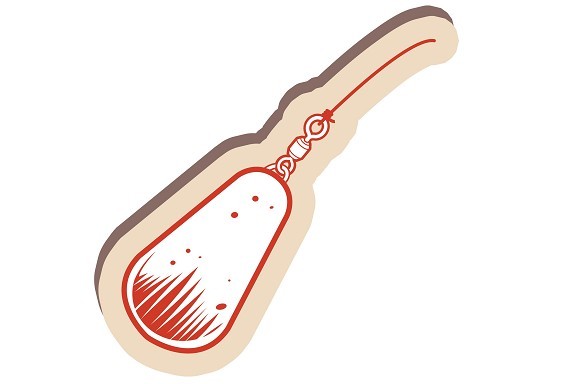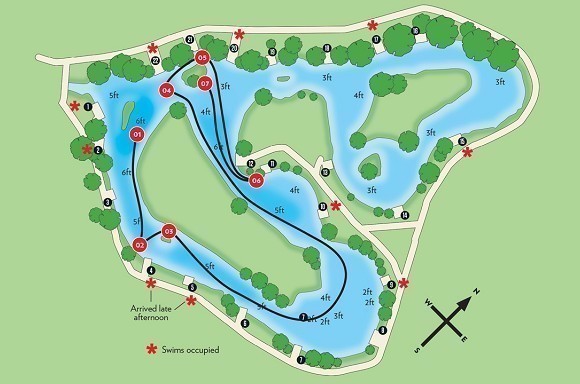
How carp react to angling pressure
Having watched, tracked and caught the odd carp, Ben Gratwicke shares his experiences on how carp react to angling pressure…
If there is one angler on a lake then the fish will either cope with it or keep at a safe distance. If the lake starts to get busy then carp will naturally head for either quieter areas, snags or weed and often sulk in theses areas whilst the day-to-day fishery life goes on. If the lake is never busy and sees little or no pressure then carp will go about their life as normal and become very catchable if they can be found. However, on the other end of the scale, if the lake is David Ram Jam Rodigan, then the carp in this lake will be on their guard all the time and seeking any small, quiet corners or areas out of reach. If they do feed, then their guard will be up and great care will be taken. Often the only option is to get amongst it and try to outwit the carp at their own game with different bait situations, rigs or time, BUT if you can, find that un-fished quiet area then you might be quids in.
We chipped a carp!
CARPology, along with Ben Gratwicke (the author of this article) and Mr. William (Bill) Beaumont who works for Game & Wildlife Conservation Trust, chipped a carp (we named him Billy) at Diggerlakes so we could study its movements and understand what affects its behaviour. Here’s the result…
1: Sluices; 2: 2nd Sluice; 3: 3; 4: Sedges; 5: Sedges; 6: Brambles; 7: Small Steps; 8: Inlet; 9: Back Bay; 10: Middle Bay; 11: Middle Bay 2; 12: Cut off; 13: Cut Through; 14: Cut Through 2; 15: Tyre Bay; 16: Big Steps; 17: Tyre Island; 18: Narrows; 19: Narrows; 20: Big Junction; 21: Behind Island; 22: Small Junction
How our chipped carp reacted to a change in angling pressure
Weather conditions
Pressure: 1018mb
Temperature: 16 degrees
Wind direction and strength: South, southwesterly, gusty at times
General: Cloudy with sunny intervals with occasional rain
Angling pressure
Swims occupied 1, 2, 9, 10, 15, 17, 20, 22 from 6am or overnight from Saturday then 4 and 5 from 3pm till dusk
8am: Billie was in front of Swims 1 and 2 between the islands in around 6ft of water (Movement 1). This is the largest area of deep water on the lake and generally has fish in it at all times due to the depths and the cover from the islands. Due to the angling pressure, Billie was not stationary and was moving in this area. I walked the entire lake checking tickets and talking to anglers which probably took an hour.
9am: I then returned to where I had left Billie and she had moved from in front of 1 and 2 and ended up in front of Swim 4 which was free of anglers. Swim 4 and 5 are narrow swims with 4-5ft of water with 4 having a big over hanging tree to the left of it (Movement 2) and between 4 and 5 is the dot island with a channel for them to hide behind (Movement 3). Her move corresponded with the anglers in 1 and 2 re-casting and making changes to their rod positions with the angler in 2 fishing further into the channel.
10am to 12pm: Billie spent the bulk of the middle day in Swims 4 and 5 where there was no angling pressure.
3.30pm: Two anglers had turned up at 3pm and were busy spodding and casting out. I caught up with Billie in Swim 22 (Movement 4) and over the space of 45 minutes she covered 22, 21 (Movement 5) and out in front of 12 (Movement 6) and ended up in front of 21 on the far side of the island in the channel (Movement 7). Swims 20 and 22 had been vacated and have the largest area of open water on the whole lake and are very popular with not only the anglers but also the fish. Swim 20 is fished a lot and there are always ‘some’ fish in there, BUT they can be tricky to catch.
Comments
Through the course of the day Billie had sought either one of the widest parts of the lake or an area with no anglers which would make a lot of sense. Any extra noise such as casting out or spodding moved her accordingly and the weather conditions had played no real part in her whereabouts. Due to the shape of Snails Lake the fish do tend to move from the pressure as it is very narrow and they are relatively new to the whole ‘day ticket life’. The movements and timing of them didn’t surprise me and when I saw the two anglers in 4 and 5 I suspected Billie would have moved. A fairly straightforward day with regards to why Billie moved: angling pressure!



